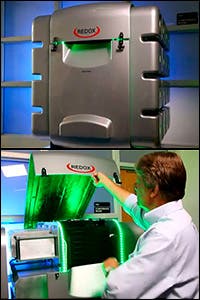There’s been a lot of praise and finger pointing alike around the hydrogen economy, and whether or not fuel cells can be scaled to reasonable levels i.e. becoming actually useful. There are a lot of problems with fuel cells in terms of their economy. Fuel cells are some of the most efficient energy converters current technology has fostered so far, it’s also 100% clean if renewable hydrogen is used. It’s goddamn expensive, though, mostly because the extensive use of platinum that goes into the catalysts and top things over their life cycle isn’t that great.
Things might pick up for fuel cells though. For one, although the most popular choice right now, you don’t necessarily have to use hydrogen and you don’t necessarily have to use noble meals as catalysts. A group of researchers at University of Maryland Energy Research Center founded a company called Redox Power Systems, LLC under the flag of which they released one of the most exciting energy products I’ve seen in quite some time. A four inch black box–the size of a large washer or dryer capable of generating 25Kw of power. To be more precise, it’s a solid-oxide fuel cell that runs on methane, which right now is widely available and cheap, that differs a lot from its conventional counter-parts. For one, it’s fantastically efficient and it’s developers claim it’s projected to produce electricity for $1 per watt, down from $8 in today’s commercial versions.

Above: “The Cube”: Redox’s 25kW PowerSERG system contains 32 solid oxide fuel cell stacks, which can be individually replaced. Although Redox is currently designing stationary generators, the technology could also be adapted for use in vehicles. Below: Materials Science & Engineering and Chemical & Biomolecular Engineering professor Eric Washsman opening The Cube to check its fuel cell stacks.
That’s a lot cheaper than using diesel for instance in an internal combustion engine and a lot cleaner. Basically, anywhere cheap natural gas is readily available these things could work. Each cube is capable of supply 25kw or enough to power a strip mall. The cell is made out of 32 stacks, can operate at 650 °C, down from 900 °C in existing products, reducing thermal stresses and insulation needs. Of course, smaller models should become available for home users.
In other words, what up and coming technology like the Redox box spell is energy independence. Today’s electric grid is technology outdated and under far too much stress. Decentralized electricity is viable solution to ease this stress away, but diesel generator energy is much more expensive than the grid. Microgrids fueled by such fuel cells are a different story, however. According to the company the first products should be shipping in 2014. Exciting times ahead.










